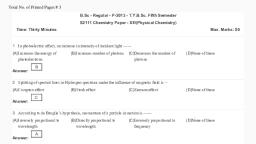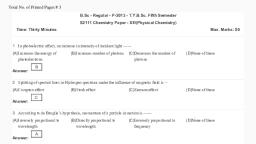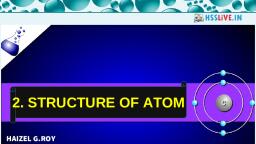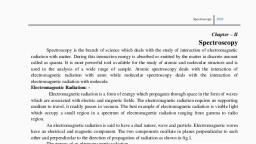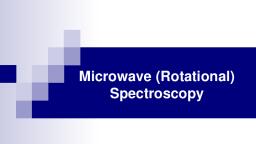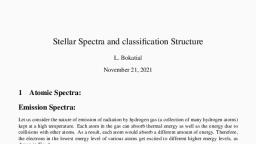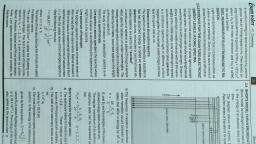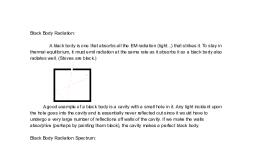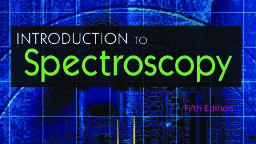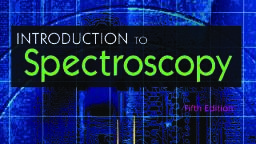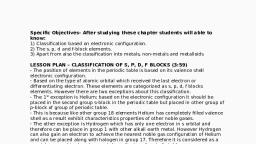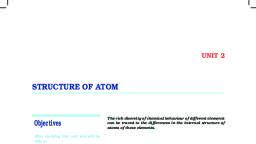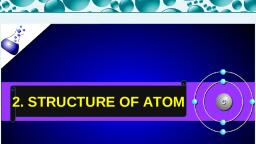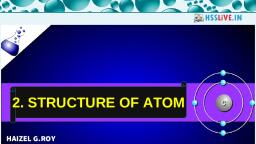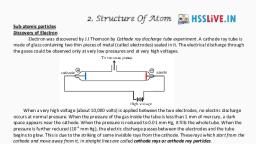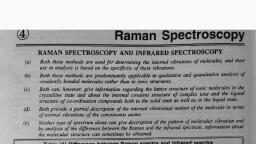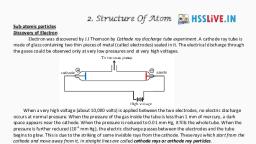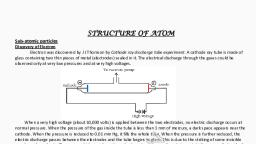Page 2 :
Chapter 4: Spectroscopy, • What is spectroscopy?, • Characteristics of spectra, – continuous, emission, absorption, – Kirchoff’s law, • Structure of the atom, – Bohr model, • Transitions and spectra, – atoms, molecules, • Astronomical information from spectra, – Fraunhofer lines, – wavelengths, intensity, broadening
Page 3 :
Information from Spectra, Almost all that, we know, about planets,, stars, and, galaxies is, obtained from, studies of the, light received, from them.
Page 4 :
Spectral Lines, • Newton:, –sunlight through pinhole to, prism, –spectrum = continuous rainbow, • Blackbody radiation:, –radiation at all wavelengths, –spectrum = continuous rainbow
Page 5 :
Blackbody Radiation, • Consider an idealized object that, absorbs all the electromagnetic, radiation that falls on it - called a, “blackbody.”, • A blackbody will absorb all energy, incident on it and heat up until it is, emitting energy at the same rate that it, absorbs energy., • The equilibrium temperature reached is, a function of the total energy striking, the blackbody each second.
Page 6 :
Characteristics of Blackbody, Radiation, , • Three characteristics of a blackbody :, 1. A blackbody with a temperature higher, than absolute zero emits some energy, at all frequencies (or wavelengths)., 2. A blackbody at higher temperature emits, more energy at all frequencies, (or wavelengths) than does a cooler one., 3. The higher the temperature of a, blackbody, the higher the frequency, (the shorter the wavelength) at which the, maximum energy is emitted.
Page 7 :
Blackbody Radiation, • Blackbody radiation:, the distribution of, radiation emitted by any, heated object., • The curve peaks at a, single, well-defined, frequency and falls off to, lesser values above and, below that frequency., The overall shape (intensity vs frequency) is, characteristic of the radiation emitted by any object,, regardless of its size, shape, composition, or, temperature.
Page 8 :
Planck Spectrum, • As an object is heated,, the radiation it emits, peaks at higher and, higher frequencies., • Shown here are curves, corresponding to, temperatures of, 300 K (room temperature),, 1000 K (begin to glow deep red), 4000 K (red hot), and, 7000 K (white hot).
Page 9 :
Spectroscope
Page 10 :
Spectral Lines from Sunlight, Wollaston (1802), – sunlight through slit to prism, – spectrum = rainbow with holes, , Fraunhofer (~1812), – cataloged over, 600 dark lines
Page 11 :
Another Type of Spectra, • Further study revealed, that if gases are, heated until they emit, light, neither a, continuous nor a, spectrum with dark, lines is produced., – A spectrum made up, of bright lines appears., , • Also, each element, was discovered to, produce its own, distinctive pattern of, bright lines., – Used as a way to, identify the, composition of an, unknown substance.
Page 12 :
Continuous Spectra, Radiation is distributed over all, frequencies, not just a few, specific frequency ranges.
Page 13 :
Emission Spectra, Pattern of bright spectral lines, produced by an element.
Page 14 :
Absorption Spectra, Pattern of dark spectral lines, where light within a number of, narrow frequency ranges has, been removed.
Page 15 :
When are Each of the Three, Types of Spectra Observed?, • The situation in which each of the, three types of spectra is observed, was summarized in a set of rules, by Gustav Kirchoff in the 1860’s., • These rules are known as, “Kirchoff’s laws”.
Page 16 :
Kirchoff’s Laws, •, , 1st law: A luminous solid or, liquid, or a sufficiently dense, gas, emits light of all, wavelengths and produces a, continuous spectrum of, radiation., , •, , 2nd law: A low-density hot, gas emits light whose, spectrum consists of a, series of bright emission, lines which are, characteristic of the, chemical composition of the, 3rd, gas.law: A cool thin gas, absorbs certain wavelengths, from a continuous spectrum,, leaving dark absorption lines, in their place superimposed, on the continuous spectrum., , •
Page 17 :
Observed Spectra and Background, Type of spectrum seen depends on the temperature of, the thin gas relative to the background temperature., , TOP: thin gas cooler than background, absorption lines seen., BOTTOM: thin gas hotter than background, emission lines seen.
Page 18 :
How are Spectral Lines Created?, • In the last chapter, stated that, – electromagnetic waves are, created by moving charges and, – all matter is composed of atoms,, which are in turn composed of, • protons (+ charge),, • electrons (- charge), and, • neutrons (neutral charge), , • Is there a connection between, composition of matter and, the spectral lines produced?
Page 19 :
Structure of the Atom, • For at least 25 centuries, matter believed, to be made of tiny particles -- atoms., • Newton thought that atoms were hard, and indivisible., • Complex structure of the atom not observed, until 20th century., – In 1897, J.J. Thomson discovered the electron., •, , plum pudding model, , – In 1911, Ernest Rutherford detected atomic nucleus., •, , alpha particles shot at thin gold foil
Page 20 :
Rutherford Model, of the Atom, • Early models of the atom are like a miniature solar, system with the electrons orbiting the nucleus, just, as the planets orbit the Sun., • The electrons must be in motion., (e and p attract each other;, stationary e, would fall into nucleus.), • Most of the atom is empty space., • Problem:, don’t atoms emit, , Since e are in motion, why, E-M radiation continuously?, , Why don’t e lose energy and spiral into nucleus?
Page 21 :
Bohr Model of the Atom, • “Planetary model” of the atom., – Neutrons and protons occupy a dense, central region called the “nucleus”., – Electrons orbit the nucleus much like, planets orbiting the Sun., , • Modifications, – Only certain select radii are possible, for the electron orbits., – If an electron moves in an allowed orbit,, it radiates no energy., – The amount of energy required to move, from one orbit to another is fixed., , E
Page 22 :
Photons, E, , • Electrons may exist only in orbitals, having, certain specified energies., • Atoms can absorb only specific amounts of energy, as their electrons are boosted to excited states;, atoms emit only specific amounts of energy when, their electrons fall back down to lower energy, states., • The light absorbed or emitted must be in, “packets” of electromagnetic radiation containing, a specific amount of energy., • These packets are called “PHOTONS.”, • The energy of a photon is related to the frequency, of the electromagnetic energy absorbed or emitted.
Page 23 :
Frequency and Energy, The energy of a photon is related to the, frequency of light emitted or absorbed, by, , E = hf, , where h = Planck’s constant, Recall that wave speed relates frequency and, wavelength:, v = f, and for light, c f, so,, , E f, , or E 1/
Page 24 :
“Every physicist thinks he, knows what a photon is., I spent my life to find out what, a photon is and I still don’t, know.”, Albert Einstein
Page 25 :
Emission, , Electrons drop to, lower energy, levels, releasing energy, in the form of, EMR
Page 26 :
Absorption, EMR is absorbed, by electrons, allowing a, reaction to take, place
Page 27 :
Hydrogen Atom, •, , •, , •, , •, , •, , The energy of particles in, Bohr atom are restricted to, certain discrete values., The energy is quantized., – only certain orbits with, certain radii are allowed;, – orbits in between simply, don't exist., Energy levels labeled by an, integer n - called a, quantum number., The lowest energy state is, generally termed the, ground state., The states with successively, more energy than the ground, state are called the first, excited state, second excited
Page 28 :
Terminology, • The “normal” condition of an atom is called the, ground state., – minimum energy configuration of the atom, , • If an orbiting electron is given enough energy to, escape the atom, the atom is said to be ionized., • Between ground state and ionization, the electron, can only exist in certain well-defined excited states., – Each excited state has a specific energy (quantized)., – Electrons moving from one energy level to another,, absorb or emit an amount of energy equal to the, difference between the energy levels., – The energy is absorbed or emitted in the form of a, photon., – The energy of the photon is proportional to frequency.
Page 29 :
Excitation and Emission, • If an atom is given, energy, electron, may jump to a, more distant orbit., • Atoms do not stay, in this energized, state long., • Electron will fall, down to a lower, orbit, emitting a, photon.
Page 30 :
Hot Gas Spectra, • The visible spectrum of, the hot gases in a, nearby star-forming, region known as the, Omega nebula (M17)., • Shining by the light of, several very hot stars,, the nebula produces a, complex spectrum of, bright and dark lines, (bottom)., • Spectrum also shown, as an intensity trace, What type of spectra is this, from red to blue (center), (continuous, emission, or absorption)?, .
Page 31 :
From Atoms to Molecules, If two or more atoms combine, to form a molecule, do the, electron energy levels and,, consequently, the observed, spectra change?, If so, how much?
Page 32 :
Molecular Motions, Three ways molecules can change, to emit or absorb E-M radiation., change electron arrangement, , (e.g., electron in the outermost, orbital of the oxygen atom, drops, to lower-energy state), , change rotational state to, a lower energy mode, change vibrational state to, a lower energy mode
Page 33 :
Hydrogen Spectra, , (a) Molecular Hydrogen, (b) Atomic Hydrogen
Page 34 :
Information from Spectra, • High temperatures, atoms mainly ionized., – Spectrum is continuous., , • Cooler temperatures, more bound electrons, making transitions., – Spectral lines help determine chemical, composition., , • Spectral line strength depends on, – the number of a specific type atoms in the gas, – the temperature of gas containing atoms, • number in each excited state, • collisions
Page 35 :
Spectral Linewidth, • May expect narrow, distinct, spectral lines., • Physical mechanisms can, broaden spectral lines., – Doppler Effect, • Thermal motion, • Rotation, • Gas Turbulence, – Collision Broadening, – Magnetism
Page 36 :
Doppler Effect:, Thermal Motion of Atoms, • Atoms moving randomly., • Redshifted, blueshifted, and, unshifted emission lines, created with respect to the, observer., • In the detector,, individual redshifted, and blueshifted, emission lines merge, with the unshifted, lines to produce, broadened spectral
Page 37 :
Doppler Effect: Rotation, • Rotation of star/, gas will produce a, broadening of, spectral lines., • Photons emitted, from side spinning, toward us,, blueshifted., • Photons emitted, from side spinning, away from us,, redshifted., , Observed spectral, line is broadened.
Page 38 :
Doppler Effect: Turbulence, • If gas in a cloud is churning in eddies and, vortices of different sizes, spectral lines, from each of those parts of the cloud will, be Doppler-shifted randomly wrt another, part of the cloud., • If the cloud is far away or small, light from, all parts of the cloud will be blended in the, detector., • Overall effect similar to thermal broadening,, but NOT related to temperature of the gas.
Page 39 :
Spectral Linewidth, • Physical mechanisms, can broaden spectral, lines., – Doppler Effect, • Thermal motion, • Rotation, • Gas Turbulence, – Collision Broadening, – Magnetism
Page 40 :
Spectral Information from Starlight, Observed Spectral, Characteristics, , Information Provided, , Peak frequency or, wavelength, (continuous spectra only), , Temperature, , Lines present, , Composition, Temperature, , Line intensity, , Composition, Temperature, , Line width, , Temperature, Turbulence,, Rotation Speed, Density,, Magnetic Field, , Doppler shift, , Line of sight velocity
Page 41 :
What’s important?, , • spectroscopy definition, • spectra: continuous, emission, absorption, – How is each of the above formed?, – Kirchhoff’s Laws, • relationship between type of spectra observed and, necessary conditions for that observation., , • “fingerprinting” composition, • atoms, • protons, electrons, neutrons, • structure: Bohr model of the atom; quantization, • relationship between structure and spectra; photons, , • spectral line broadening: possible causes, • information from spectra

